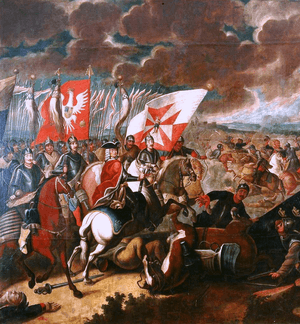Battle of Kalisz
| ||||||||||||||||||||||||||||||
The Battle of Kalisz took place on October 29, 1706 in Kalisz, Polish-Lithuanian Commonwealth during the Great Northern War. It was a three-hour fight which could have been prevented if Augustus II of Poland had informed the Swedes and Russians of certain matters. At the time, an alliance existed between the Poles, Saxons, and Russians. The battle was fought by Russian cavalry, led by commander Aleksandr Menshikov; against a smaller Swedish force headed by colonel Mardefelt. The Russians played a role of significance here because they needed to support their Saxon allies under Augustus.
Prelude
Charles XII of Sweden's victory in the Battle of Fraustadt had forced August the Strong of the Electorate of Saxony to drop out of the Great Northern War and abdicate his claims to the Polish crown in the Treaty of Altranstädt, marking an end to the Civil war in Poland (1704-1706).[4]
When he learned of the recently arranged treaty while on his travels with Menshikov, Augustus chose to keep the news from him. His decision was based on the Russians' support through generosity in expenses. They were prepared to fight for him and Augustus could not risk angering his ally with the recently learned information. His last attempt to mend the situation was also unsuccessful. He sent word to the waiting Swedish force begging them to retreat upon meeting, but Mardefelt, having been unaware of the treaty, interpreted the plea as a trick of battle. As a result of poor communication, and to Augustus' dismay, the Battle of Kalisz did occur.
At the time, king Augustus of Poland, also the Electorate of Saxony, had in secret negotiated a peace treaty with the swedes. This because after five years of marching, war and burning, the swedes had attacked Augustus where it hurt; his own electorate. Thus, the main Swedish army was at the time in Saxony.
August himself, however, was with the Russian commander Menshikov and the third Russian army, which numbered 20 000 Russians. These were sent by Tsar Peter after the previous two had been defeated and dispersed. August had not informed Menshikov of the peace treaty because of the large contributions from Russia, and tried to avoid a battle, as he knew that his deceit would anger the swedes.
August secretly sent a letter to the Swedish major general Arvid Axel Marderfelt who was in command of the small Swedish army stationed in western Poland. August declared that the peace was almost concluded, and that he hoped to be informed of this by the Swedish king, Charles XII, and that a battle would thus be avoided. Marderfelt had, however, not been informed of this (the couriers had most likely been killed by kossacks). Marderfelt thus concluded that the letter was yet another of Augusts' deceits and replied that he had not received any information of the peace and would stand his ground in the case of a battle. In reality, he was more concerned than he wished to admit.
Battle
To the number, the Swedish army was vastly outnumbered with only 4 000 infantry troops, if it had not been for the allied Polish and Lithuanian cavalry. Mardefelt did not wish to engage the much larger Russian army, but the commander of the Polish crown army, Józef Potocki, insisted on chasing the Russians out of the country. Mardefelt pointed out carefully that the Poles had not been keen on fighting Russians or anyone at all during the war, but Potocki convinced him that this time they would fight to the last drop of blood.
When the battle commenced, the Swedish infantry lined up in the middle with the Polish and Lithuanians on the sides, protecting the flank. When the Russians advanced, the poles immediately fled the battlefield and thus left the Swedish flank exposed. The Swedish infantry fought on, even though the outcome would be obvious.
Aftermath
The Swedish defeat was rendered moot when Charles XII exposed Augustus' ratification of the Altranstädt treaty, whereupon the latter gave in to obey by its terms and withdrew to Saxony by November.[4]
Also, although he had planned to originally renounce the Treaty of Altranstädt, Augustus went along with its terms. Finally 1,800 Swedish prisoners were returned.
Sources
References
- 1 2 The Battle of Kalisz, Oct. 29, 1706. Jan Wimmer, 1961
- 1 2 Gordon A. The History of Peter the Great, Emperor of Russia: To which is Prefixed a Short General History of the Country from the Rise of that Monarchy: and an Account of the Author's Life, Volume 1. Aberdeen. 1755. p. 228
- ↑ Kuvaja, Christer (2008). Karolinska krigare 1660–1721 (in Swedish). Helsingfors: Schildts Förlags AB. p. 171. ISBN 978-951-50-1823-6.
- 1 2 Frost (2000), p.230
Bibliography
- Frost, Robert I (2000). The Northern Wars. War, State and Society in Northeastern Europe 1558-1721. Longman. ISBN 978-0-582-06429-4.
- Jan Wimmer: The Battle of Kalisz
- Robert K. Massie: Peter the Great
